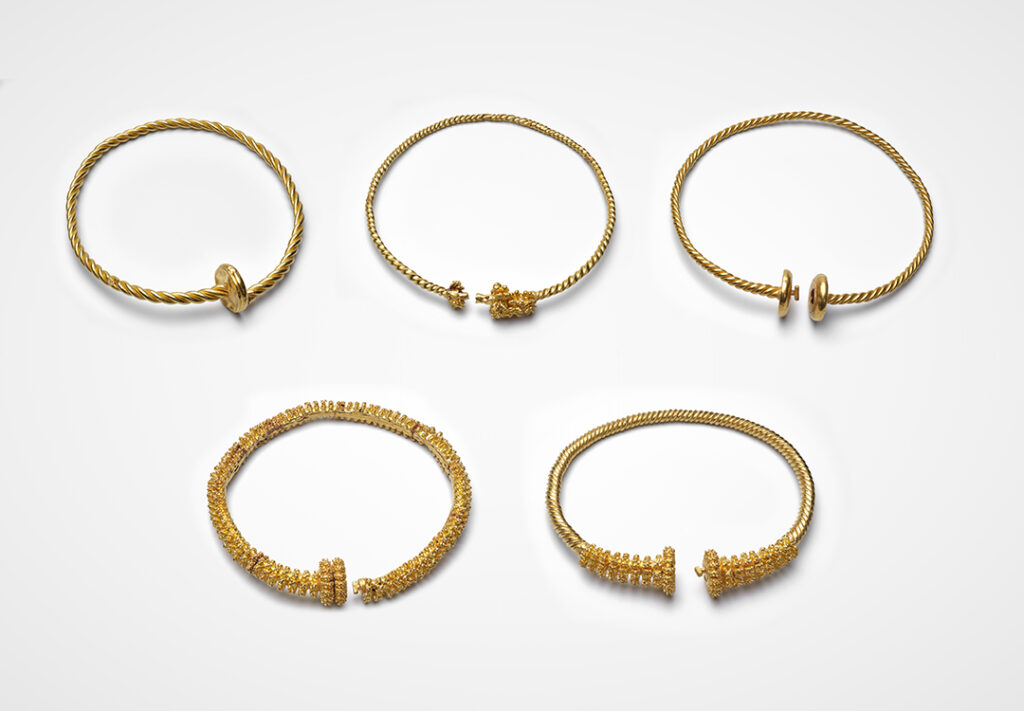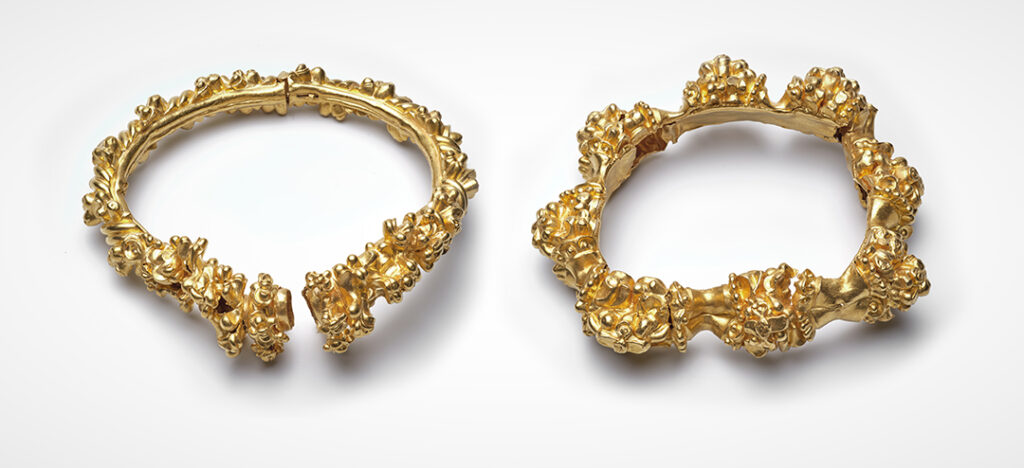Family jewels?
This is a very prestigious set of objects, Gallic torcs! These gold neck rings and arm rings are among the museum’s major artefacts. Everything about them is reminiscent of the ceremonial jewellery of a wealthy social class in the Toulouse region during the 3rd century BC.

These objects were not discovered in the same place, as the first five come from Fenouillet, North of Toulouse, the other two from Lasgraïsses in the Tarn region. Two places of origin, two ways of unearthing them. On the one hand by digging the Canal Latéral (Lateral Canal) of the Garonne River in 1841, and on the other hand by stumping up vine stocks in 1885. To top it all off, the artefacts from Fenouillet were found in a pot, while the artefacts from the Tarn region were found together with pottery and animal bones of all kinds: pig, ox, deer and even horse! Quite a story, after all.

These objects were made by goldsmiths of exceptional technical skill, who may have worked in workshops in South-West Gaul. Made from almost pure gold coming from local water streams, these objects were worked with sheet metal or gold rods, finely twisted, meticulously crafted, conscientiously soldered and assembled. Indeed, you might not notice it at first, but the two artefacts from Lasgraïsses are hollow, unlike the others, the bangle of which was twisted and folded to be properly shaped. As for the decoration, it certainly reflects the influence of the best Greek craftsmen from Magna Graecia, in Southern Italy, between 500 and 300 BC.
In the Celtic world, the owners of these torcs wore them during parades, fights or prestigious banquets. They were symbols of both warlike and religious power. Depending on the period, both men and women wore these incredible ornaments. Sometimes they were found in graves with their owners, accompanying them to the other side. Why bury such objects, you ask? Well, their respective owners may have gifted them to the gods. Quite a gift indeed! But you know how it is, nothing comes for free! The gods need to receive gifts in order to listen to a request, and what better gift than a bangle? Because although they received jewels, the main thing they were given was a quantity of gold. Gold still holds great value for the gods.
TECHNICAL SHEET: THE TORQUES FROM FENOUILLET
Name
Penannular torc with buffers and clasp; penannular torc with sleeves, buffers and clasp; penannular torc with buffers and clasp; tubular torc with double clasp; penannular torc with sleeves, buffers and clasp.
Material
Gold
Place of discovery
Fenouillet (Haute-Garonne)
Manufacture date
3rd century BC
Inventory numbers
25049; 25047; 25048; 25045; 25046
Whereabouts
Permanent collection, 2nd floor
FOR FURTHER INFORMATION
- Scientific note on torc 25049 ⬈
- Scientific note on torc 25047 ⬈
- Scientific note on torc 25048 ⬈
- Scientific note on torc 25045 ⬈
- Scientific note on torc 25046 ⬈
- Photos to download ⬈

TECHNICAL SHEET: JEWELLERY FROM LASGRAÏSSES
Name
Tubular neck with double clasp; arm ring.
Material
Gold
Place of discovery
Lasgraïsses (Tarn)
Manufacture date
First half of the 3rd century BC
Inventory numbers
25043 and 25044
Whereabouts
Permanent collection, 2nd floor
FOR FURTHER INFORMATION
- Scientifc note on torc 25043 ⬈
- Scientific note on cuff 25044 ⬈
- Photos to download of torc 25043 ⬈
- Photos to download of cuff 25044 ⬈

